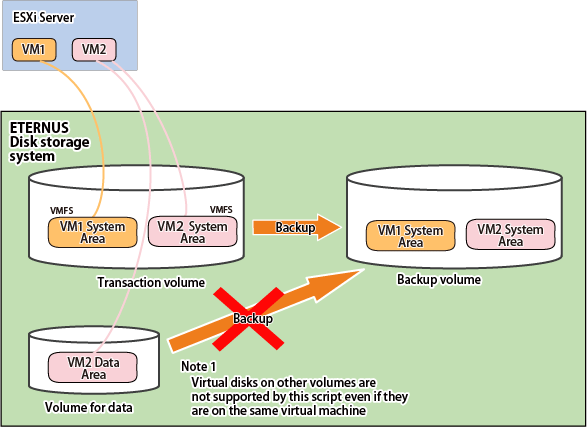Designing Server Configuration
This server manages and operates all virtual machines.
AdvancedCopy Manager CCM is installed, and acts as a backup server.
This server provides a virtual machine execution environment.
The VMware script may also be used in the following environments where VMware vSphere is in operation.
vSphere HA
vSphere DRS
vMotion
Storage DRS
Storage vMotion
Note
When using Storage DRS or Storage vMotion feature, the destination must be within the same ETERNUS Disk storage system.
Designing Volume Configuration
Design a volume (LU) configuration that meets the following requirements.
The transaction volume, backup volume, and restore volume are placed on the same ETERNUS Disk storage system.
The transaction volume and backup volume are an Open Volume of the same size.
The restore volume is a Snap Data Volume, and is of the same size (logical capacity) as the transaction volume.
The transaction volume and restore volume are connected to the ESXi Server.
The backup volume is not connected to the ESXi Server.
The formula for estimating the transaction volume size is as follows. If the capacity that is bigger than the estimated size can be allocated, bigger capacity is recommended to be allocated.
[System Area size : for 20GB or higher] transaction volume size = System Area size (size of virtual disk for guest OS) * 2 [System Area size : less than 20GB] transaction volume size = System Area size (size of virtual disk for guest OS) + 20GB
Notes When Virtual Machine Is Constructed
The following notes apply when building a virtual machine (VM) on the ESXi Server.
Virtual machines to be backed up/restored using these VMware scripts are those created on a VMFS-5 datastore. Always select a VMFS-5 datastore when building a virtual machine.
Only the System Area on the transaction volume will be backed up/restored using these VMware scripts.
You may create multiple virtual machines on a single transaction volume.
Create a Data Area of virtual machine for other than the transaction volume. The following may be used for the Data Area:
VMFS-5 Independent (Persistent)
RDM Compatibility Mode Physical (*1)
RDM Compatibility Mode Virtual Independent (Persistent) (*1)
*1: Be sure to allocate the LUN mapping for the RDM on the same business volume as the System Area.
Connect all virtual disks including the System Area of a virtual machine with SCSI.
The following guest OS are supported:
Windows Server 2003
Windows Server 2008
Windows Server 2008 R2
Windows Server 2012
Windows Server 2012 R2
Red Hat Enterprise Linux 5 (for x86)
Red Hat Enterprise Linux 5 (for Intel64)
Red Hat Enterprise Linux 6 (for x86)
Red Hat Enterprise Linux 6 (for Intel64)
SUSE(R) Linux Enterprise Server 11 for x86
SUSE(R) Linux Enterprise Server 11 for EM64T
In this VMware script, the virtual machine snapshot is acquired in the snapshot name called "ETERNUS_Backup". Do not acquire the snapshot of the same name to avoid the repetition of the snapshot name.
Figure E.4 Configuration Image of Volumes Backed Up / Restored Using These VMware Scripts
